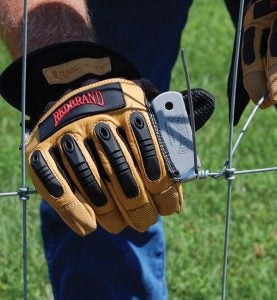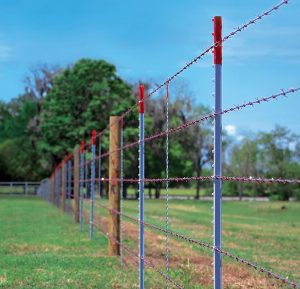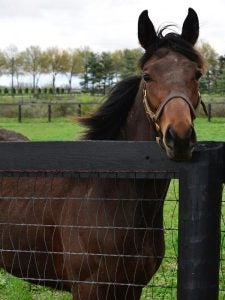A lot of work goes into getting farm fencing just right, and it starts with deciding between woven wire, barbed wire, electric, or another material that’s available.
When planning your farm fence, you need to know the pros and cons of different fencing materials like wood, electric, steel, or wrought iron. Some of these options are durable, others are affordable; still others are flexible and easy to install. Each type isn’t without its disadvantages as well: Some are expensive, some are prone to corrosion, and others require frequent maintenance.
Before you choose a farm fence, read our post to guide you through each stage:
Planning your farm fence
Map it out
Map out all fence lines, lanes, corners, and gates. Using lath, surveyor tape, bright paint, or a long tape measure, mark the future location of these fence elements.
Permanent fence vs. temporary fence
Temporary fencing is easy to install, move, or remove if you decide to build a stronger fence. There are two main types of temporary fencing: ready-to-use kits and temporary lines or wire. The latter comes in a spool and is set up across posts. Within a permanently fenced-in enclosure, you can use temporary fencing to protect your animals from sink holes, water sources, eroded areas, or trees.
Temporary fencing is usually made of light, durable materials like bare wire, braided wire, or tape. Generally, these materials are electrified because it’s very easy for animals to get tangled in or tear down the fencing.
Permanent fencing choices include woven wire, electric, vinyl, or wood rails. They are much more appropriate for long-term use. Some farmers choose to include temporary fencing materials like tape or wire fencing along with PVC or wood rails to fortify the barrier. If you opt for permanent fencing, you’ll have to concrete the posts into the ground. This type of fence needs more frequent maintenance because wood rail fencing involves nails.
Not only does permanent fencing make it harder for your animals to escape, it also makes it less likely for wildlife to penetrate the enclosure. In addition, a well-built permanent fence can withstand almost all weather conditions. Permanent fencing can be electrified or non-electrified.
Locate fencing lanes and gates
Ideally, your fencing lanes should connect working facilities, livestock buildings, and water with every potentially pastured field. You should make lanes in the driest possible areas, such as along a natural ridge or terrace. Red Brand’s Fence Calculator allows farmers to find their property via satellite online and map out the area they want to fence in to find the linear feet needed.

Selecting the fencing material
Woven wire
Woven wire fences consist of a number of smooth horizontal wires held apart by stays (vertical wires). This type of fencing comes in a variety of height options, so your choice depends on what animals you are rearing and how high they can jump.
Mesh wire fence
Mesh wire fences are durable and reliable, and often more affordable than woven wire. They are used mainly to fence in feedlots, corrals, or small crop acreage areas.
Barbed wire
Barbed wire fences are made of several strands of galvanized steel wire twisted together with two or four barbs. There are two types of barbed wire fences: standard and suspension.
Barbed wire fences are inexpensive and require only wire, fence posts, and staples as fixing devices. They are easy to build and erect.
Electric
Electric fences are a secure, effective and affordable means of temporary or permanent fencing if built properly. Polywire strands are commonly used and are more visible to animals. Steel, aluminum, and high-tensile wire conducts electricity more effectively over longer distances, and are harder for livestock to see.

Building the fence
Establish fence lines
Take your time to lay out the fence lines carefully. Make sure you know where the property lines are to avoid drama with neighbors or placement errors. Avoid stony areas, rough terrain, and steep climbs when laying out the fence’s path. After a fence line section is leveled, replace the vegetation to prevent weed growth and erosion.
End, corner, and gate post brace assemblies
Setting end, corner, and gate post braces is the key to quality fence installation. Experts recommend using exclusively CCA pressure treated posts. The concrete footings for the upright corner and end posts should be bell-shaped. Always face diagonal brace footing off. Increasing the diameter of all gate, end, and 90-degree corner posts to a minimum of 8 inches will limit tension loss and lessen the number of failures. Always assemble the brace cable starting at the base of all corner, gate, and end posts, then to the top of the brace post if your top member is horizontal.
Corner braces can be an N-brace, an H-brace, or a brace with a wood post at the top. If a corner brace features two H-braces back to back, then two horizontal braces, three vertical posts, and bracing wire were used to construct it. This is a standard, highly durable design that will support almost any fence for a long time.
Post spacing
According to a blog post by Red Brand, the most recognized brand of farm fence products in the U.S., most fence posts can be spaced 8-to-12 feet apart. For example, a square 40-acre pasture would need one mile of fence. You can space posts from 8-to-12 feet apart. A reliable structure will have a ratio of five steel T-posts to one wooden post. You’ll need 660 posts to space them 8 feet apart. In comparison, you’ll need 440 posts for 12-foot spacing. The difference comes to 220 posts, which is important in terms of labor and material cost.
Attaching the wire
You should attach the first wire from 8-to-10 inches off the ground. This step is generally not required for temporary electric fences, board fences, or rail fences.
For the next wires, you’ll need to decide how many strands you want, in particular if you’ve opted for a wire fence. Normally, a fence line would need around four. Some farmers prefer to install five or six-wire fences, especially in high-traffic areas.

Ongoing maintenance
Wire fences tend to loosen naturally with temperature changes and time. You need to inspect them on a regular basis to make sure the tension is right. Regardless of the type of fence you’ve chosen, check the post assemblies for maintenance issues regularly. Use herbicides to clear weeds from fence lines. If herbicides are not advisable, remove them manually.
Next steps
Animals’ safety and health are every farmer’s and rancher’s top priority. More detailed information about fencing is available at Red Brand’s website.
Dain Rakestraw is the Director of Marketing and Brand Management at Red Brand, a line of premium agricultural fencing products that is known as the most recognized brand of agricultural fencing in the United States.
Sources:
MMC Fencing and Railing
Farm and Dairy
Home Guides
Cheshire Horse


